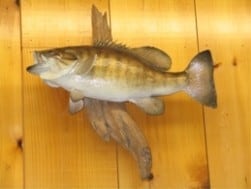Showcase Your Prize Catch

Some anglers will get one of their trophy fishes mounted. However, having a trophy fish mounted usually means it’s a very large fish that has lived a very long time.
If you choose not to get your catch mounted, practice “Catch-N-Release”. Remember to take a clear pictures of your catch.
There are many taxidermists out there who focus on mounting fish and will work on your catch. There are high costs associated with getting your catch mounted. Most mount the fish onto driftwood or other nature like objects. If done right, it’s worth the price.
Anglers are starting to take pictures and measurements of their catches and sending them to a taxidermists to create a replica of their fish vs. mounting the actual fish. This is slightly less costly and they do a wonderful job. If that is the direction you plan on, make sure you take pictures of all sides of your catch. This way the taxidermists can see all the details of your catch.
If you plan on getting your fish mounted, after reeling in your catch, you must take care of the fish and protect the skin from damage. The better the condition of the skin is the better your final product will look. The fish should be kept cool on ice. Most place the fish in the freezer for storage before going to the taxidermist.
You must preserve your fish before you place your fish in the freezer. Clean all the dirt off the fish by running it under clean water. Pat the fish dry. Spread each fin and tail out to their full size. Place a piece of cardboard underneath each fin. The cardboard should be larger than the fin itself. Place pins through the fin to the cardboard about an inch apart of each other. This is done to hold the fin in place with the cardboard.
Place a piece of cardboard underneath the gill cover of each side of the fish. Hold it in place with pins. Once completed, place the fish in a large plastic bag. Seal the bag and place it in another bag and seal that bag. Place the fish in the freezer; make sure you lay it out flat. Make sure nothing is placed on top of the fish as the weight of an object can crack or break off a fin.
Which every direction you plan on going, make sure you hire someone who is trustworthy whom others have used.

